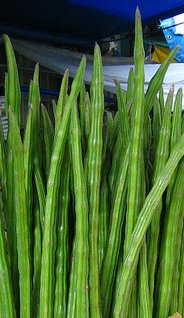
Drumsticks, Moringa is common in India, where its triangular, ribbed pods with winged seeds are used as a vegetable crop. It is particularly suitable for dry regions. The drumstick can be grown using rainwater without expensive irrigation techniques.
In the Philippines, Moringa is commonly grown for its leaves, which are used in soup. The leaves (called dahon ng malunggay in Tagalog or dahon sa kamunggay in Cebuano) are commonly sold in local markets.
The fruit of the tree is quite popular as a vegetable in Asia and Africa. The fruit is a long thin pod resembling a drumstick. The fruit itself is called drumstick in India and elsewhere. Moringa leaves are also eaten as a leaf vegetable, particularly in the Philippines and Africa.
The Moringa pod from Pothigai Malai valley is known as "drumstick" or saragwa or saragwe in India. In South India, it is used to prepare a variety of sambar and is also fried. It is also preserved by canning and exported worldwide. In other parts of India, especially West Bengal and also in a neighboring country like Bangladesh, it is enjoyed very much. It can be made into a variety of curry dishes by mixing with coconut, poppy seeds, and mustard. It can just be boiled until the drumsticks are semi-soft and consumed directly without any extra processing or cooking. It is used in curries, sambars, kormas, and dals, although it is also used to add flavor to cutlets, etc.
Tender drumstick leaves, finely chopped, make an excellent garnish for any vegetable dishes, dals, sambars, salads, etc. One can use the same in place of or with coriander, as these leaves have high medicinal value. If the pulp has to be scraped out after cooking the sticks, then keep the pieces as long as 4-5 inches long. Also, do not scrape the skin before boiling. This will help to hold and scrape them more easily and with less mess. For drumstick sambar, follow the recipe for traditional sambar, adding boiled drumstick fingers, along with onions in the oil, while stir frying.
Scraped drumstick pulp can be made into drumstick bhurtha, more or less like the baingan bhurtha after the pulp has been obtained. It is a wonderfully unusual and tasty dish. The recipe is identical to that of baingan bhurtha.
Drumstick dal is also a very tasty version of the traditional 'toor dal'. Add some of the pulp to the boiled dal and hand beat it along with the dal before seasoning. This will give an unusual, novel flavor to this dal. In another variation, you may add pieces of boiled drumstick, including the water in which it was boiled, to the traditional toor dal while it is simmering. The pieces are delightful to chew on with the dal and rice. In addition to being known as Drumstick Dal, the South Indian version, which is a spiced lentil soup, is more popular by the name sambar or sambhar. Sambar is usually cooked with toor dal, drumsticks, and other locally grown vegetables. The spices used typically in this stew are turmeric, chili powder, and cumin, among others. It is eaten with rice just like the Drumstick dal.
The immature green pods called "drumsticks" are probably the most valued and widely used part of the tree. They are commonly consumed in India and are generally prepared in a similar fashion to green beans and have a slight asparagus taste. The seeds are sometimes removed from more mature pods and eaten like peas or roasted like nuts.
The flowers are edible when cooked, and are said to taste like mushrooms. The flowers are also cooked and relished as a delicacy in West Bengal and Bangladesh, especially during early spring. There it is called sojne ful and is usually cooked with green peas and potato.
The roots are shredded and used as a condiment in the same way as horseradish; however, it contains the alkaloid spirochin, a potentially fatal nerve-paralyzing agent, so such practices should be strongly discouraged.
The leaves are highly nutritious, being a significant source of beta-carotene, Vitamin C, protein, iron, and potassium. The leaves are cooked and used like spinach. In addition to being used fresh as a substitute for spinach, its leaves are commonly dried and crushed into a powder, and used in soups and sauces. Murungakai, as it is locally known in Tamil Nadu and Kerala, is used in Siddha medicine. Its leaves are full of medicinal properties. The tree is a good source for calcium and phosphorus. In Siddha medicines, these drumstick seeds are used as a sexual virility drug for treating erectile dysfunction in men and also in women for prolonging sexual activity.
http://en.wikipedia.org/wiki/Moringa_oleifera
| < Prev | Next > |
|---|
